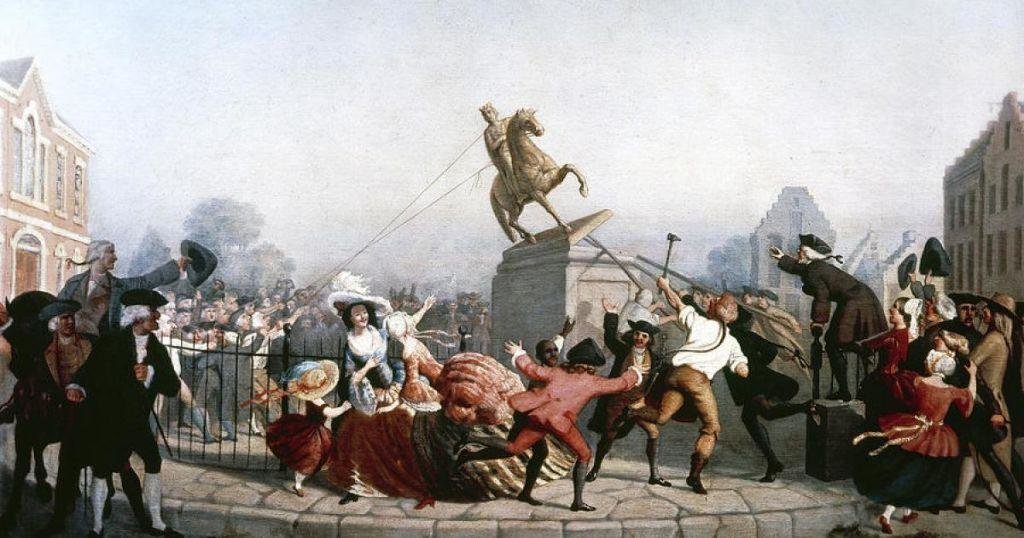George simply became ammunition
jmp.press@gmail.com
The removal of Confederate statues around the country has sparked heated debate. Many communities are looking at their own monuments and wondering whether they should stay or go. Another statue was …
This item is available in full to subscribers.
Subscribe to continue reading. Already a subscriber? Sign in
Get 50% of all subscriptions for a limited time. Subscribe today.
Please log in to continueNeed an account?
|
George simply became ammunition
jmp.press@gmail.com
The removal of Confederate statues around the country has sparked heated debate. Many communities are looking at their own monuments and wondering whether they should stay or go. Another statue was taken down 243 years ago. While the circumstances were different, it was still a major moment during the Revolutionary War and worth revisiting. Here’s what happened when New Yorkers gave it the heave-ho.
Back in 1766, the Province of New York (the British colony that became today’s New York State) wanted to score some brownie points with the boss back home. They passed a resolution honoring England’s King George III. In language that would make the most fawning, fanny kissing sycophant blush, their resolution noted “…the innumerable and singular Benefits received from our most gracious sovereign, since the Commencement of his auspicious Reign, during which they have been protected from the fury of a cruel, merciless, and savage Enemy …” It ordered a gilt-covered lead equestrian statue of him to be erected in New York City.
So George was placed atop a pedestal in Manhattan’s Bowling Green neighborhood on March 21, 1770. Although the statue went up amid great fanfare the timing was lousy, for some Colonists were beginning to demand a break from the mother country.
It came in 1775 with the “shot heard round the world,” the opening battle of the Revolutionary War. When the Declaration of Independence was signed the following year, George’s reputation had dramatically deteriorated, going from “Our Most Gracious Sovereign” in the 1766 resolution to someone “…whose character is this thus marked by every act which may define a Tyrant …” in the 1776 Declaration.
In fact, the Declaration itself prompted the statue’s demise. General George Washington ordered it read to his soldiers in New York City on July 9, five days after its signing. The Patriots went wild with joy. That night, some 40 soldiers and sailors tied ropes around the statue and pulled. They broke. More rope was found and the men pulled again. George and his horse tumbled to the ground, shattering into dozens of glittering pieces.
Toppling the statue served two important purposes. First, it demonstrated the old order was being replaced by something new. And perhaps more importantly, it provided lead for much-needed Patriot musket balls.
George was turned into 42,088 bullets. New York’s postmaster wrote in a letter that the British troops “…will probably have melted Majesty fired at them.”
Interestingly, not all of the statue’s remains reached the Litchfield, Connecticut, foundry where they were transformed into musket balls. Some Tories (Americans who remained loyal to the British) stole an estimated 1,400 pounds of lead chunks and secretly sank them in nearby Davis Swamp.
Then there was George’s head. The Patriots lopped it off, fired a bullet into it and stuck it atop a pole outside nearby Cox’s Tavern. That final outrage was too much for the Brits. They sent spies to pull it down and bury it. When they occupied New York days later, they exhumed the head and sent it to Lord Townshend back in England, “in order to convince them at home of the Infamous Disposition of the Ungrateful people.”
Nearly 241 years later, you can now see what the ill-fated statue looked like. A replica was made with painstaking accuracy last year. It is a featured exhibit in the brand new Museum of the American Revolution in Philadelphia, near Independence Hall.
Statues are important symbols. They are visual reminders of significant people who shaped our shared past. Toppling them can be make a political statement. (Think Lenin’s likeness coming down in the U.S.S.R.’s final days and Saddam’s statue falling after Baghdad’s liberation.) They can be wartime morale boosters—as in the case of George III in New York. And they can become lost legacies when they are snatched away from citizens who grow careless with their culture.
Email Mark at jmp.press@gmail.com.
Keywords
holy cow history, king george III, king georgeOther items that may interest you







Comments
No comments on this item Please log in to comment by clicking here